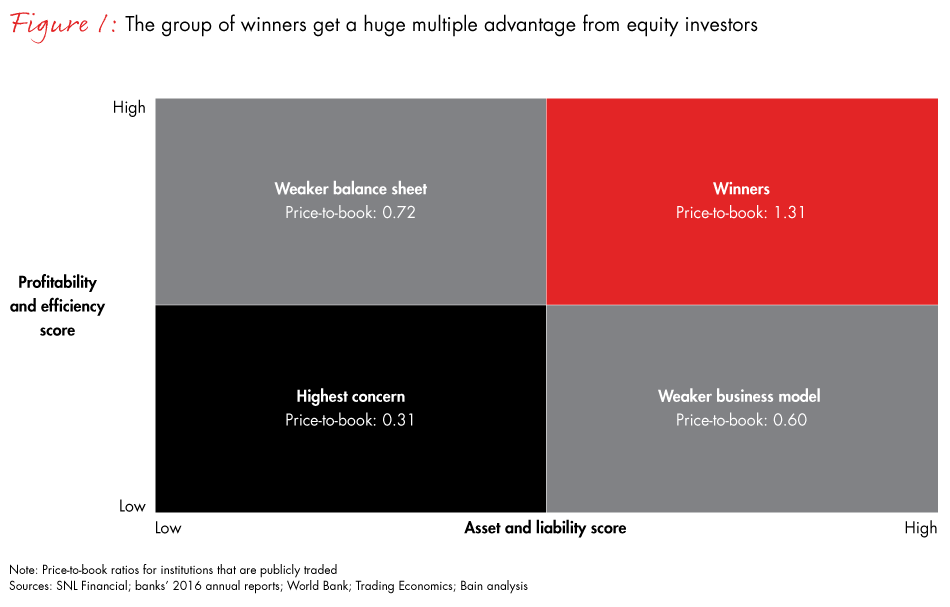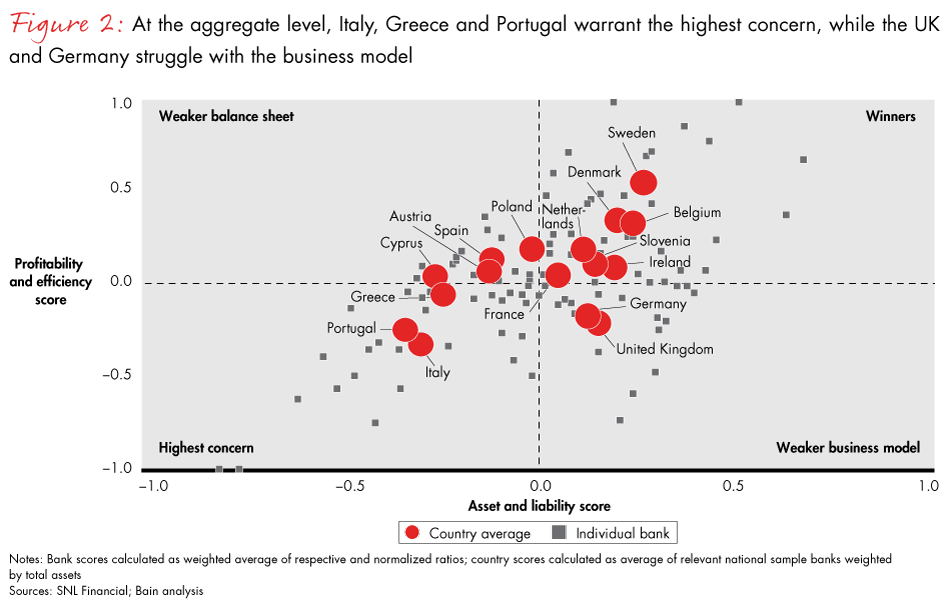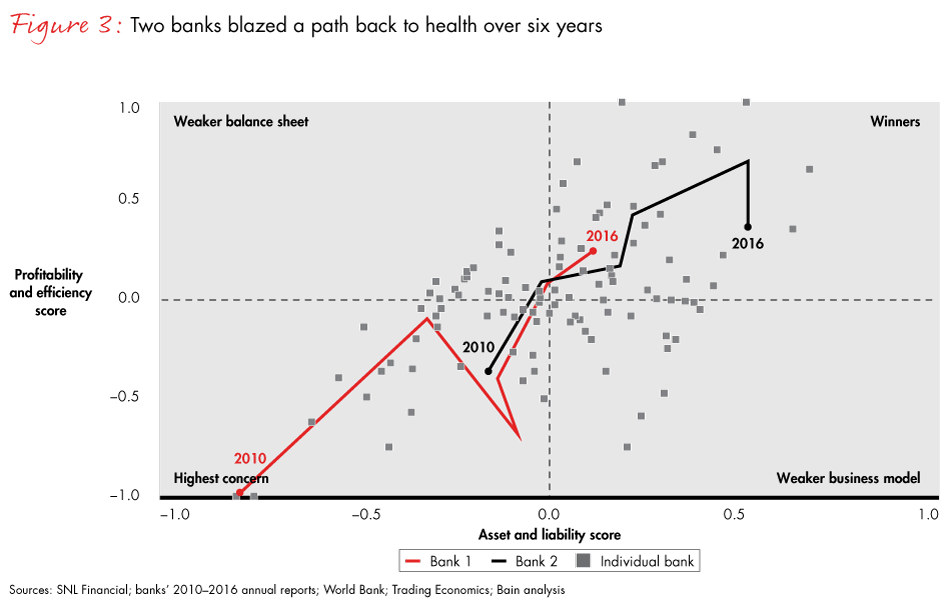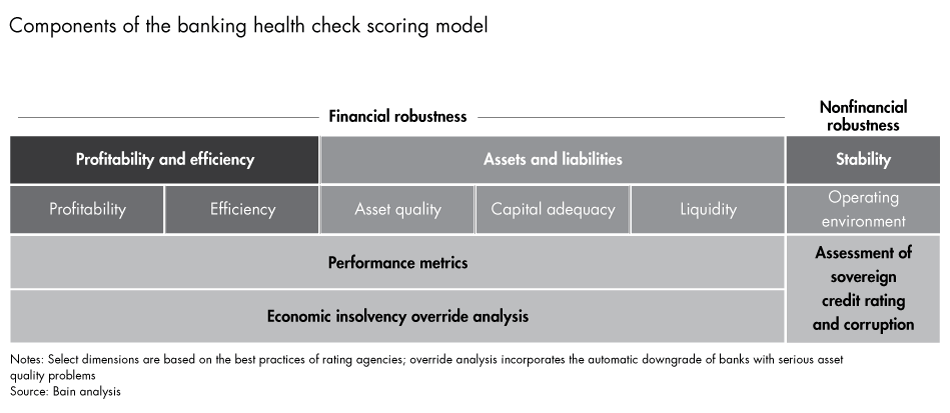Brief

European banks as a whole are running hard just to stand still. Sure, in light of the higher capital buffers they have erected, the banks might appear to be fairly resilient when viewed through recent stress tests by regulators. But in reality, reflections on average for European banks are next to useless in a continent of many distinct markets. A select group of banks that are performing well on a range of indicators have been increasing their lead over persistent laggards—particularly in the multiple accorded by equity investors. Indeed, the listed winners have more than a four times price-to-book ratio advantage over those banks at greatest risk of failure or bailout.
Yet the past decade has shown that any bank at any point along the spectrum can return to good health through a proven formula—that is, if the regulators, board and senior executive team have the commitment to carry out the hard decisions required over three to five years.
These conclusions emerge from Bain & Company’s 2017 health check of the banking system, the fourth annual analysis covering 111 banks in the base study. Our health check scoring model derives from three dimensions, two of which represent banks’ robustness (see the sidebar, “How the scoring model works”):
-
profitability and efficiency;
-
asset and liability health (here, we give a relatively heavy weighting to asset quality as essential for future earnings); and
-
stability of the operating environment.
Our scoring brings together data from financial providers such as SNL Financial and Moody’s and combines their findings with banks’ own financial statements. The health check provides a uniquely integrated view, which stands in contrast to looking only at a balance sheet or income statement. Based on the combination of the critical financial ratios, we calculate a score for each bank and place it in one of four categories (see Figures 1 and 2).
João Soares, a partner with Bain's Financial Services practice, outlines a proven formula that can help any bank become a winner in three to five years.
Winners. Some 38% of banks have attained this strong position. Scandinavian, Belgian and Dutch banks figure prominently in this group, outperforming on virtually all financial indicators.
Weaker business model. Banks in this quadrant continue to represent about 17% of the total. What may surprise some observers is the number of UK and German banks, including names that used to be references for good health, struggling to find a viable business model. In fact, virtually all the large German names fall into this category as their profitability and efficiency sit at a level comparable with their Greek counterparts.
Weaker balance sheet. Some 17% of banks have a priority to fix weak balance sheets, compared with 21% in 2013. Over the years, banks in this quadrant have shown vulnerabilities not yet fully reflected in their profit and loss statements. A leading Spanish lender, for instance, moved from this quadrant to the quadrant of highest concern in just two years.
Highest concern. Of the total base, 28% of banks flash a high-risk signal, up from 26% in 2013. Banks in Italy, Greece, Portugal and Spain form the bulk of this quadrant and have become a breed apart in continued distress. Every single bank that has failed in the past decade and for which there are financial statements available, as well as many banks that have merged into other entities, such as Spanish cajas or savings banks, fell into this quadrant before their demise. Executives at many of these banks either lacked an integrated view or were in denial about the warning signs.


The cost of inertia is striking, with investors rewarding the winners with a 1.31 price-to-book ratio and punishing the high-concern banks with a 0.31 price-to-book ratio. Equity markets also seem to reward banks with weak balance sheets, assigning them a slightly higher price-to-book ratio of 0.72 vs. banks with weak in-year profitability and efficiency, which were assigned a price-to-book ratio of 0.60.
Ultimately, the health check should prove its usefulness by helping banks analytically determine their relative position and thus get clarity about how to improve that position on a number of fronts. To that end, there is a proven formula for moving up—even from the dark reaches of highest concern to the promised land of winners. The experiences of two banks illustrate that migration (see Figure 3). Their journeys were difficult and required painful choices, but ultimately paid off with much more robust, stable and profitable institutions. What follows are examples of actions that the two banks took.

-
Significant shrinkage of the balance sheet. Both reduced their risk-weighted assets by about 50%, their gross loan amounts by between 25% and 30%, and their problem loans by 70% to 75%. Restructuring troubled loans took a major commitment of time and effort as bankers had to figure out how to dispose of repossessed factories and other assets. They persisted, having realized that allowing nonperforming assets to sit on the balance sheet would require more capital every month and further impair the enterprise.
-
Growing revenue by improving customer loyalty and advocacy in the new digital world. Net interest margin as a share of risk-weighted assets more than doubled. This occurred after both banks embarked on an ambitious reassessment of the markets in which they operate for their retail and business segments. They discarded legacy bets and focused on new profit pools.
These new models involved a systematic mapping of customer episodes in both personal banking and business banking. (An episode consists of the interactions customers perform when they have a task to complete or a need to fulfill.) Episodes that the banks redesigned ranged from new ways of risk pricing and attracting new card customers to speeding up the process of onboarding corporate customers. By adopting highly digital business models and improving various customer episodes, both banks achieved significant increases in customer loyalty and business. One saw an increase of 30 points over three years in its Net Promoter Score®, a key metric of loyalty.
-
Adjusting the cost base to reinvest in new activities. Both banks decided to pursue cost reductions through what we would now call zero-based redesign programs. This differs from traditional budgeting processes by examining all expenses for each new period, not just incremental expenditures in obvious areas. A zero-based approach puts the onus on managers to justify the costs that need to be kept—a subtle but powerful shift in perspective from what should be removed. As a result, one of the banks that published its performance results reduced its cost base by around 30%. Zero-basing freed up funds (up to one-third of the original savings) to reinvest in a more simple and digital business model featuring remote account management, straight-through processing and simpler product suites aimed at more carefully selected segments of customers.
-
Changes to the mix of funding. The two banks’ deposit levels rose by 20% to 25%, while they reduced wholesale funding by between 70% and 80%. Reduced dependency on wholesale funding marked a major departure from the previous makeup of the balance sheets.
With relatively new and ever-increasing regulatory frameworks from the European authorities taking hold, including the Supervisory Review and Evaluation Process and greater scrutiny of nonperforming exposures, European banks cannot afford to ignore any of the data that signals vulnerable points within the institution. Taking an integrated view is essential for understanding how to return to robust health. The good news: Troubled banks can likely quadruple their market value by taking the right actions.

How European Banks Can Get Stronger
Many European banks continue to struggle. But there is a proven formula that banks can use to right themselves.
How the scoring model works
The scoring model in Bain’s health check of the banking system gathers data in six areas, with the heaviest weighting on asset quality (see figure).
Profitability: The key determinant of sustainable success or failure, it measures the ability to create economic value and to preserve or improve risk protection for creditors. Performance metrics include pre-provision income as a percentage of risk-weighted assets and net income as a percentage of risk-weighted assets.
Efficiency: Cost containment is a strategic focal point; it allows banks to satisfy stakeholders’ requirements without overly aggressive risk taking. Performance metrics include operating expenses as a percentage of net revenue.
Asset quality: A main factor in future earnings and capital generation or erosion, loan quality is a key to determining a bank’s stability. Nonperforming loans predict future losses. Performance metrics as a percentage of gross loans include problem loans, loan-loss provisions and corporate loans.
Capital adequacy: Banks typically fail due to losses in the loan portfolio, poor business models or fraud—all of which lead to a decline in capital. In the case of low profitability, capital is the most important buffer for absorbing risk costs. Performance metrics include Tier 1 capital as a percentage of risk-weighted assets and tangible common equity as a percentage of average risk-weighted assets.
Liquidity: Illiquidity is often a proximate cause of failure as banks might not any longer be able to finance themselves under pressure. Access to market funding may not be based on long-term relationships but rather on creditworthiness. Performance metrics include gross loans as a percentage of total deposits and total debt—that is, liquid assets as a percentage of total assets.
Operating environment: Bank performance is often constrained by violent economic cycles, adverse political decisions or weak legal systems. Declines in economic growth correlate highly with worsening asset quality. Performance metrics include assessment of sovereign credit rating and corruption.

João Soares is a partner with Bain & Company’s Financial Services practice. He is based in London.
Net Promoter®, Net Promoter System®, Net Promoter Score® and NPS® are registered trademarks of Bain & Company, Inc., Fred Reichheld and Satmetrix Systems, Inc.



